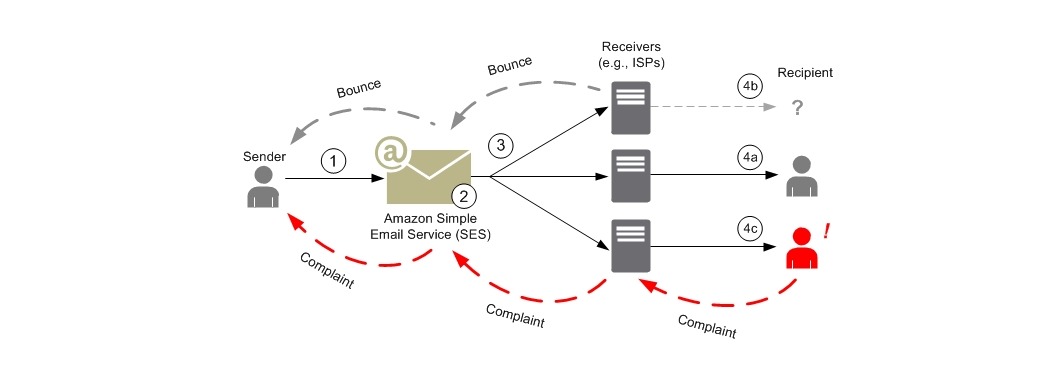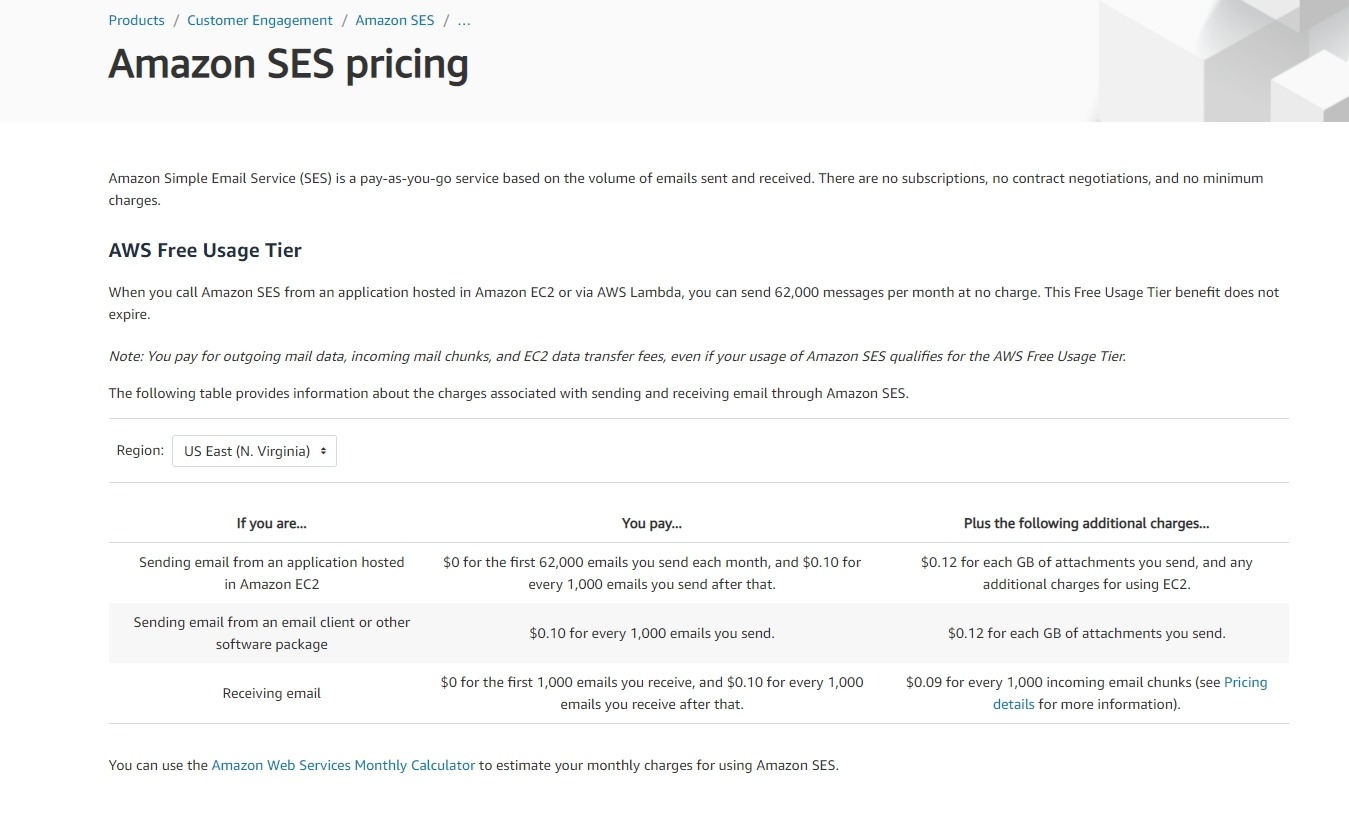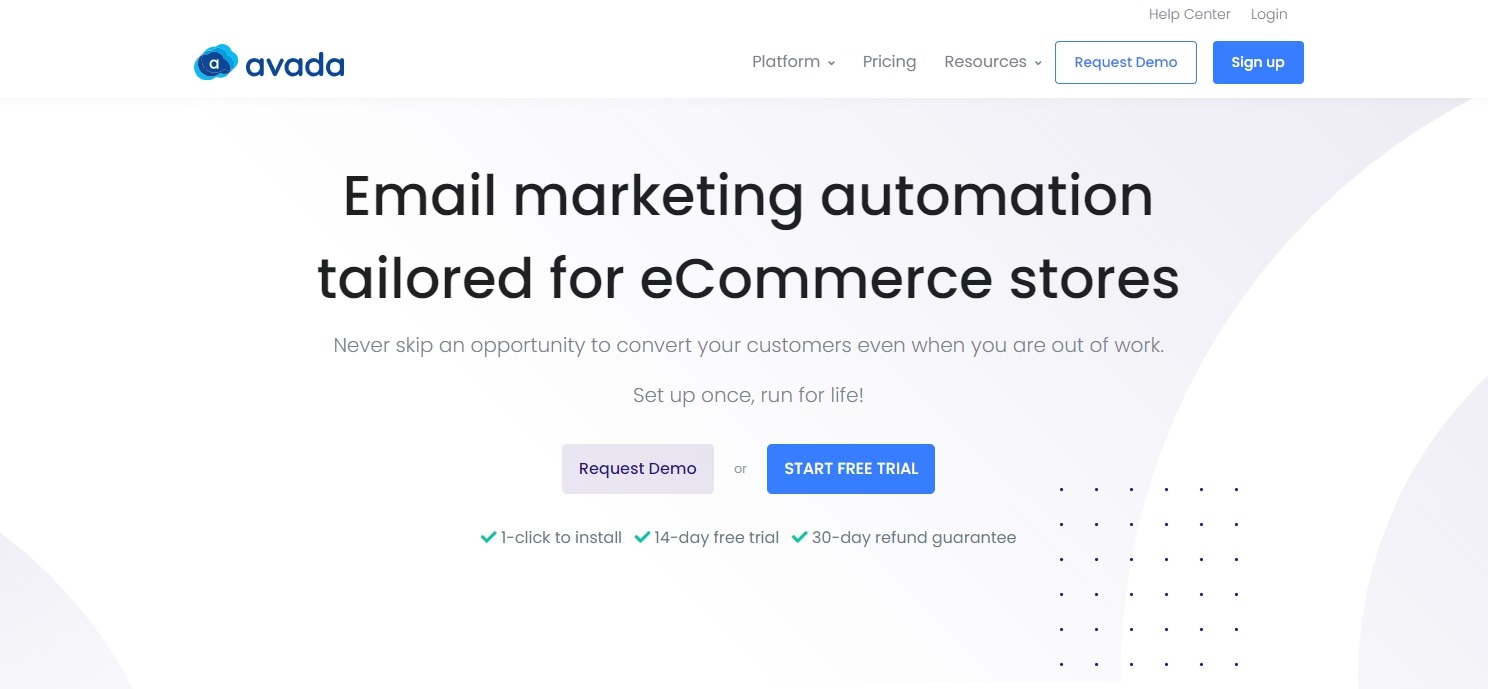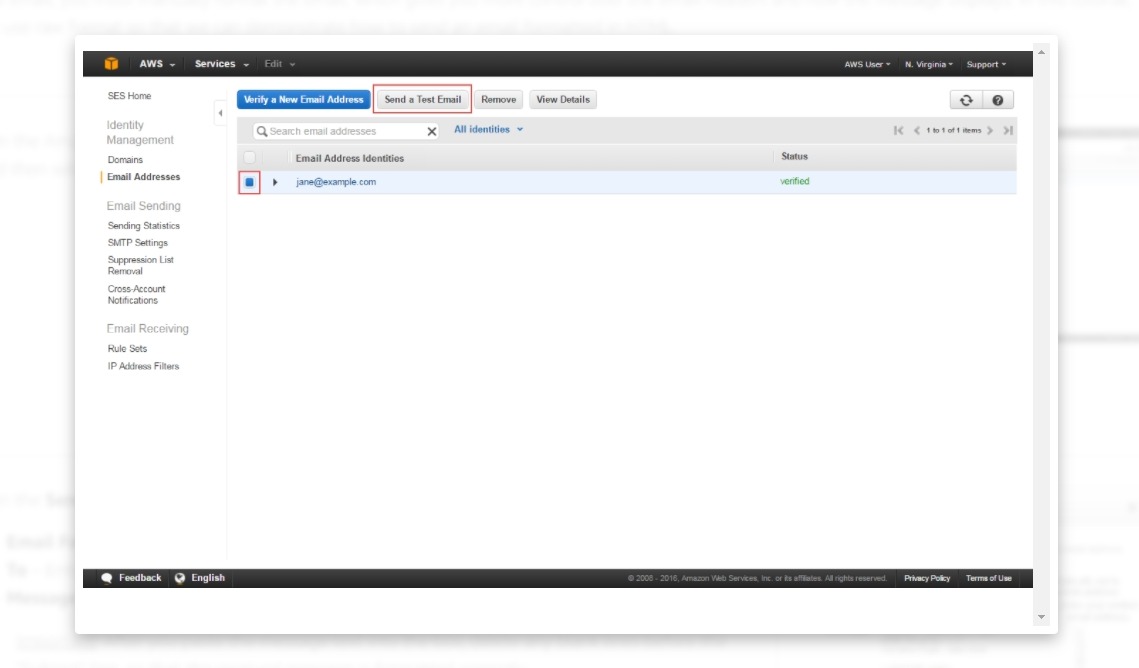Amazon Email Marketing Review: Features, Pricing & Comparison
Amazon is the #1 eCommerce market globally, so no wonder it offers some kinds of email marketing solutions for its users. Amazon Simple Email Service is an email marketing service that is designed for email marketing campaigns, web application transaction emails, company communications, and any other activities involving emails.
Since there are all sizes of companies on Amazon, the ways businesses process outgoing emails from email clients need to be different as well. For example, distinguishable from normal web-based emails, transactional emails can also include the monthly newsletter you send customers or reminder emails that you send to inform customers about an issue.
Small companies can still use Google Gmail to function their email communications and schedule emails using a third-party app. However, this method won’t work when you are sending thousands of emails every month because of the infrastructure’s complexity.
In this article, I will take a good look at Amazon’s email marketing service, see what it can do, how it can scale, and compare it to our own email marketing software - AVADA Email Marketing. Not to worry, I will be as non-judgemental as possible and show all the benefits of disbenefits, most honestly.
Let’s get started.
Amazon email marketing introduction
Amazon Simple Email Service (SES) is a part of Amazon Web Services (AWS), providing a cloud-based email marketing service. It is advertised as a cost-effective, scalable, and flexible email marketing service that can enable developers to send emails from within any application.
Amazon developed the service to serve its own massive customer base. Using Amazon Email Marketing, users can send transactional emails, mass marketing emails, and any other type of quality content to their subscribers.
Amazon SES’s flexible deployment of IP and email authentication options can drive better deliverability and protect sender reputation while also delivering analytics that can measure the impact of each email campaign. With Amazon SES, users can send email globally, securely, and at scale.
Apart from that, Amazon SES requires no commitment to start using as the users can benefit from the service and only pay for what they use. We will get more detail of that in the Amazon email marketing’s pricing section.
Amazon email marketing’s technology

Simple Mail Transfer Protocol (SMTP) is a worldwide standard for electronic email transactions. This Internet protocol is widely used in functioning an email marketing campaign in the online world.
The acronym of SMTP is pretty much the backbone behind all email flows on the internet. As a matter of fact, the process of delivering an email is quite similar to delivering mails in the traditional way. A well- structured system of SMTP acts as the ‘postman’ throughout the email sending process.
Once the email has been selected, the system sends the email through a server which tactfully delivers emails to the exact recipients. Amazon SES is a popular SMTP server and widely used by a large number of email marketers. You can see the full journey of an email with the SMTP server of Amazon Email Marketing in the picture above.
However, in spite of helping many email marketers in the process of running email marketing campaigns, SMTP servers still lack few vital features such as a campaign management tool or a sneak peek into email delivery reports.
That said, many still view Amazon SES as one of the best transnational email services present in the market. However, I would like to point out that Amazon email marketing service can be a little bit low on providing a dedicated IP pool.
Amazon unfortunately can only provide a shared IP pool to users for the purpose of sending email campaigns from a business to the mailbox providers. Which means there is not an option for users to get a dedicated IP pool for sending emails. This subsequently blocks the path for users to build their own email sending reputation over a specific IP address.
Amazon email marketing’s features
The problem with email as a complex endeavor for companies is that they need to send thousands of messages per month from multiple email marketing apps as a part of marketing efforts. It’s difficult in part because of the massive number of emails being transmitted and also due to the strain email platforms can have.
With its giant infrastructure, Amazon SES has the back-end system to keep up with any email flow. It also has cutting edge content filtering techniques and reputation management features to avoid any issues with email regulatory compliance (so your emails won’t be labeled as spam since subscribers did opt-in to receive the messages). The service also has a vast array of reporting and analytics functions.
Let’s go into more detail about Amazon email marketing’s features now:
Inbound email processing

Truly an unique feature of Amazon SES, the system provides a facility to receive and process all incoming emails. This feature can also be an add-on benefit for users to send and receive emails easily.
Amazon SES can store incoming emails in an Amazon EC2 bucket, and users can then take advantage of the AWS Lambda to process emails using custom code. For example, if an user uses an app to send out emails about new features every month, and subscribers reply with questions, that user can create a report and a new email to answer the questions by using another service from Amazon called SNS (Simple Notification Service) that can respond based on keywords.
Amazon SES also has a handy mailbox simulator that users can use to test out their applications or WordPress site to see if the service is sending emails correctly and test if they can receive bounce/complaint notifications.
Whole package integration
One of the main benefits of using Amazon SES is to integrate it with other services in the Amazon Web Service platform. You can seamlessly use the service on a site hosted by EC2, set up custom reporting using Amazon Cloudwatch, or configure custom notifications using the Simple Notification Service (SNS).
With the Amazon SES console, SMTP, or APIs, you can configure your email sending system in minutes. Amazon SES also supports receiving emails, enabling users to interact with subscribers at scale. Regardless of sending volume or use case, you will only have to pay for what you use when selecting Amazon SES.
Secured email sending
Amazon SES authentication options such as DomainKeys Identified Mail (DKIM) and Sender Policy Framework (SPF) confirms your authority to send emails on behalf of your domain. A virtual private cloud (VPC) support helps secure email sending from any application.
Amazon SES is also globally available with in-region compliance (C5, IRAP), HIPAA eligibility, and global certifications (GDPR, Fed-Ramp, ISO).
High sending speed
With a well-made infrastructure, Amazon SES is excellent in sending emails at a high speed. They can send up to 3,000 emails per second, which is definitely a humongous number. The speed of the cloud sending is no joke, and not many email marketing services on the market can compare with such a huge email sending speed.
Flexible deployment options
By default, Amazon SES sends email from shared IP addresses with other Amazon SES customers. Shared addresses are a fantastic option for many users who want to start sending emails immediately with established IPs.
For users who want to control their own IP reputation, they can rent a dedicated IP address to use with the Amazon SES account. Users can also choose the dedicated IP grouping feature and group existing IP addresses. Users can direct all traffic from these dedicated IPs, or configure to tailor specific use cases of specific IPs.
Amazon email marketing’s limitation
One area where Amazon SES lacks is an intuitive dashboard. It can be a bit hard to navigate with a user interface much like the Amazon website. The service also lacks information unless you figure out how to use WP Offload SES to view reports and send statistics or configure custom reports in Cloudwatch.
Another limit of Amazon email marketing service is that it only allows users to white label the email sending domains. It can not provide other white labelling options for mailed by domain and tracking domain.
With Amazon SES, users get to start by sending 62,000 emails per month at no charge. However, the number of emails can go further up if users want to have a bigger list or maintain a good sending reputation. Therefore, users need to be pretty cautious about the intention of sending more emails and the price gets bigger. We will take a look at that in the next section.
Amazon email marketing’s pricing

Amazon email marketing service strongly follows the policy of paying only for what you use. Therefore, there is no minimum fee. If a person is using Amazon EC2, he/she can start sending emails for free through Amazon SES. They can indulge themselves in sending 62,000 messages per month to any number of recipients. This can only happen when the user calls Amazon SES from an application by Amazon EC2 directly or through AWS Lambda.
To make things more exciting for customers, Amazon SES lets users get the benefit of receiving 1000 messages per month for free when using the service. Due to this, many users are perfectly fine operating entirely within the free tier limit, and it won’t ever expire.
The pricing plan is something that makes Amazon email marketing service a unique SMTP server compared to other services that are available in the market. Underpaid plan, Amazon SES charges users for sending email messages at $0.10 per 1,000 emails.
For example, let’s say you use Amazon SES to receive 1,000 emails per month and send 250,000 emails per month. You don’t have a dedicated IP address. You send emails using an application not hosted in Amazon EC2. Every message you receive and send is 32KB in size. The pricing goes something like this:
Total outgoing mail charges = Outgoing messages cost + Outgoing mail data cost = 250,000 x $.0001 + 250,000 x .000032GB x $0.12 = $25.96 per month
Total incoming mail charges = Incoming messages + Incoming mail chunks = 1,000 - 1,000 free messages + (1,000 x 32KB) / 256KB = $0.02
So total charges for using Amazon email marketing service would be $25.00 + $0.20 equal $25.98 per month. The incoming mail charge is hardly a cost, so you can take that out of the equation. For a detailed pricing equator, try this Amazon pricing calculator.
You can also add a dedicated IP address for $24.95 per month. If you are not on Amazon EC2, the pricing can be a bit more expensive with the dedicated IP address and a large number of email sending.
Amazon email marketing comparison

In this section, I want to have a bit of comparison between Amazon email marketing service and our own app - AVADA Email Marketing. Being a relatively new player in the email marketing market, we want our customers to know the best about what we have to offer.
Let me just put down a small introduction first: AVADA Email Marketing is an email marketing app dedicated to helping eCommerce companies create professional email campaigns. With a reliable platform, features, and support team, AVADA Email Marketing makes it easy for email marketers to design, automate, segment, test, and successfully deliver all email campaigns.
Now, for the comparison, I will carry out a few most essential points. Let’s see what they are:
Email sending limitation
With Amazon SES
Users can send 62,000 emails for free per month if they are on Amazon EC2. If they are not, they pretty much pay for what they use as the previous section has calculated. This is a nice kind of pricing plan for small to medium sized businesses, since they can know exactly how much they would pay for their volume of email messages.
However, if the number of emails or the list gets bigger, you can quickly see the cost of Amazon email marketing going up. So, for scalability, I don’t consider this a win since every company wants to grow and have more subscribers or customers to send emails to.
With AVADA Email Marketing
You can start sending unlimited emails from just $9 per month. The price will go up based on the number of contacts you have on the list. It has its downside, though, since you will have to pay more when the list gets bigger.
But, in my opinion, this is much more handable because the number of contacts doesn’t increase by a large number in a quick time. With the number of emails, however, you may have to increase based on event and strategy. For example, if you want to run a sales event in two weeks, you will want to squeeze every email sending opportunity possible to maximize your reach and result.
Free plan
The free plan of Amazon email marketing service gives users 62,000 emails per month for free if they are on Amazon EC2, which means if you are not on this plan, you will have to pay. It won’t be much though, you will need to pay about $2.00 per month if you send 20,000 emails. The Amazon SES’s free plan is still worth considering if you are a small business and do not have a big need for sending emails.
The free plan of AVADA Email Marketing lets you send 15,000 emails per month with a list of under 1,000 contacts. The number of email is lower, but you still get access to all basic features and automation flow, taking the first step in automating your email marketing efforts. You also have a lead capture tool to turn your eCommerce website into a source for more subscribers.
Ease of use

Amazon email marketing service has a simple dashboard, that is pretty much a part of the Amazon AWS iot solutions. In the homepage of the Amazon SES, you can send test emails, see statistics, update SMTP settings, and view the email received. Since the email service from Amazon focuses more on providing an infrastructure for sending emails, you won’t have features for designing emails and automation.
However, for novice email marketing users who are new to using emails, this type of dashboard can be confusing since they don’t really know where to start.

On the other hand, AVADA Email Marketing focuses on making a convenient user experience for users to create and manage their email campaigns. Since the focus of each app is a bit different, it’s hard to criticize the design choice of each app. But, for AVADA Email Marketing, new users will be able to pick up and start using much faster thanks to the checklist available with guidance videos.
If you dig deeper, you will see the section to segment the audience, create newsletter campaigns, and build automation workflows. All of these are easy to use and provide in-depth knowledge so email marketers can know what they are achieving. For companies that want to incorporate email marketing as a part of the marketing strategy, I think this approach would be much more effective.
Pricing
As already mentioned, Amazon email marketing service’s pricing depends on what you use. The more emails you send, the more you spend. That is simple enough for a pricing plan, and surely any size of company can see how they want to use Amazon SES from that.
For AVADA Email Marketing, we have a tier pricing model, providing different features for different groups of email marketers. If you just want to use the free plan and start sending emails for a test, that is perfectly fine. But if your email list is growing bigger and you want more advanced features to keep campaigns focused, beautiful, and automated - AVADA Email Marketing also can do that.
The pricing model of Amazon SES is more straightforward but it also shows the limit in its service. With a tool like AVADA Email Marketing, you know that you are paying for a more complete power over email marketing.
Final words
But, as I said, I should keep things neutral as a reviewer. Amazon email marketing service has its advantages and certain target users. Suppose you are a seller on Amazon, for instance. Also, many email marketing apps act as a third-party company for designing and automating email campaigns using benefits from Amazon SES. You can check them out to decide on using Amazon email marketing service or not for yourself.
What do you think? Is there enough information on this Amazon email marketing review for your company? Leave your thoughts in the comment section below and let me know your opinion on the Amazon email marketing service!
New Posts






